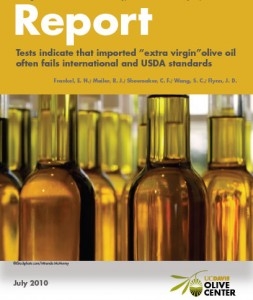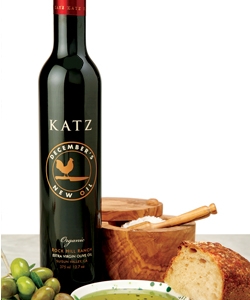Posts Tagged: Olive Center
Last call for olio nuovo
I’m slow on the artisan EVOO wave. In December, after proofreading the new issue of California Agriculture - Growing Bigger, Better: Artisan Olive Oil Comes of Age, I purchased a bottle for my partner and the next day heard a TV comedian joke about people buying $60 bottles of olive oil for holidays gifts. (Then I felt cheap — I hadn’t spent that much!)
But the tall thin black bottle of December’s New Oil from Katz and Company, near Napa, was so fabulous I decided to start learning the extra virgin olive oil (EVOO) lexicon. Did I know for sure whether it was grassy, buttery, peppery or pungent? It certainly was green. Albert Katz this week told me why: “That’s the chlorophyll in the oil; it’s at its height in olio nuovo,” he said.
When the earliest still-green olives are crushed in November, a strong odor of fresh green fills the mill, he explained. The crush smells like fresh artichoke, even parsley, but most predominantly like grass. Katz has been in the business so long that when he catches a whiff of mown grass he looks around to see whether someone is crushing olives nearby.
Darn it, though, Katz sells their olio nuovo only in December, so it’s over. The limited production and short window of sales for olio nuovo, celebrating the first crush, is a tradition in all the major olive-growing regions of the world, including northern Italy, where the name originates. The oil is always unfiltered, cloudy, and as bold as it’s ever going to be. Katz calls it “the pungency of youth.”
This week sees the very end of the season. McEvoy Ranch has bottles of their olio nuovo for sale at their San Francisco Ferry Building store and online through this weekend (February 6). The McEvoy olio nuovo is green, robust, and peppery — peppery means it has a little burn in the throat, which is a desirable quality. (Bitter is a different matter; it’s tasted on the tongue.) Like all olio nuovo, the McEvoy new oil has sediment in the bottom of the bottle, and it has an unctuous quality, a little pleasantly thick and earthy in the mouth.
With the end of the olio nuovo season comes the release of the oils that have been stored for two months; they are already changing — more mellow, more golden — and the sediment will stay in the storage tanks. As they age through spring and summer, they’ll taste more buttery.
Climate affects the taste of oil. “Terroir” is what the environmental factors are called, explain Paul Vossen and Alexandra Kicenik Devarenne in the California Agriculture article on sensory qualities of olive oils. Katz tastes some roundness and softness in his oil this year, from the cool summer and late harvest.
Different varieties of olive trees produce markedly different aroma compounds. Tuscan varieties, grown by both Katz and McEvoy Ranch, have robust aroma profiles (full-bodied, pungent, complex). A few stores down from McEvoy at the San Francisco Ferry Building, Stonehouse sells its milder EVOO, pressed from Spanish olive oil varieties Mission, Manzanillo, Sevillano, Ascolano and Arbequina. The Stonehouse oil isn’t spicy; it doesn’t burn the throat.
Last week, Katz released its main oils for 2011: Chef’s Pick Organic Extra Virgin and Rock Hill Ranch Extra Virgin. Rock Hill doesn’t taste like the olio nuovo, because a significant proportion of the olives in it are Taggiasca, and they weren’t harvested until after the olio nuovo was made. Chef’s Pick, though, has the same profile, Katz says. Now I know a little of the language, I think I’m going to investigate further and buy a bottle before it sells out. If I wait until summer, I’m told the green will be gone and the grassiness turned more herbal.
For more information on tasting olive oils, check out the UC Davis Olive Center; in August, they have introductory and advanced seminars on sensory evaluation of olive oil.
Paul Vossen is a UC Cooperative Extension farm advisor and expert on olive oil processing tasting; watch his video on tasting here.
Alexandra Kicenik Devarenne showed Sacramento Bee reporter Gina Kim in this video how to taste oil and recognize fustiness.
The California Olive Oil Council website lists farm tours and tasting rooms.
The Olive Oil Times has an archive of articles on tasting, including one on recognizing rancidity.
Why does my pesto turn brown?
I don’t know if plant scientists make better chefs, but knowledge of plant science can certainly improve our cooking. Take, for example, understanding how to handle oxidation, the interaction between oxygen molecules and all the many substances they may contact. Oxidation is what makes your fender rust and your copper penny turn green. As it relates to plants, oxidation is what causes fresh-cut produce to turn brown and wine to lose its flavor when left too long in an open bottle.
Perhaps you know how to thwart oxidation when preparing potatoes and serving sliced apples (and if not, we’ll get to that in a minute) but here is a less-common food that often falls victim to oxidation: pesto. Has this happened to you? You gather an armload of picture-perfect basil, blend it together with olive oil, pine nuts, garlic and cheese and produce a fantastic pesto sauce for your spaghetti. Fresh from the blender, it’s as green as your holiday tree. But by the time you serve it an hour later, it’s a dull shade of olive brown and has lost much of its taste. Oxidation strikes again.
Here’s a handy plant-science trick: Blanche your basil. Heat destroys the enzymes that cause oxidation and the resulting discoloration. Drop your fresh basil in a pot of boiling water for a few seconds and then shock it in a bowl of ice water. Dry it completely, proceed with your favorite recipe and your pesto will stay green and tasty for days. Here’s the recipe I like to use:
- 2 cups packed fresh basil leaves
- 2 cloves garlic
- 1/4 cup pine nuts (I use walnuts when I don’t have pine nuts)
- 2/3 cup extra-virgin olive oil, divided (for special treat, try using a UC Davis olive oil
- Salt and pepper, to taste
- 1/2 cup parmesan or other hard cheese
Combine the basil, garlic and nuts in a food processor or blender and pulse until coarsely chopped. Add 1/2 cup of the oil and process until fully incorporated and smooth. Season with salt and pepper.
If you’re eating it right away, add all the remaining oil and pulse until smooth. Transfer the pesto to a large serving bowl and mix in the cheese. Yum! If you’re freezing it (up to three months), transfer to an air-tight container and drizzle remaining oil over the top. Thaw and stir in cheese.
You can learn more about handling fresh-cut produce at the UC Davis Postharvest Technology Center and explore the joys of plant science at the UC Davis Department of Plant Sciences website.
Starting a rEVOOlution
A traditional crop is getting a modern makeover – and UC Davis is cultivating its growth in California.
The UC Davis Olive Center last month hosted a symposium on super-high-density olive production – a relatively new practice that has fueled the expansion of California’s olive oil industry. The production system, developed in Spain, reached the Golden State in 1999 and has taken off in the past five years. California accounts for almost all domestic olive oil production – now 850,000 gallons a year – and is poised to become a global player.
“California could within the next 10 years rank among the top 10 olive oil producers in the world,” said Dan Flynn, executive director of the UC Davis Olive Center.
Traditionally, olives have been planted at about 100 trees per acre and harvested by hand. Super-high-density olives are planted at more than 500 trees per acre and harvested by machine. The method lowers harvesting costs and speeds the turnaround from orchard to mill, a key to freshness and flavor. More than 100 growers attended the sold-out symposium to get the inside scoop – “a great deal of useful information,” Flynn said.
The self-funded UC Davis Olive Center, launched in 2008, is the only academic center of its kind in North America. Collaborating with industry, it published an olive production survey in November. The center made headlines with its just-published study that many premium-priced imported olive oil brands labeled as extra virgin – even those of EVOO queen Rachael Ray – aren’t as pure as they claim (California oils fared better). Upcoming projects could include research on super-high-density yields, costs and compatibility.
With olive oil consumption growing nationally, the climate is right in California, which has about 17,000 acres of super-high-density olives after 4,500 acres were planted in 2009. The most popular regions to grow olives for oil are Glenn and San Joaquin counties, putting Davis at the heart of the movement.
UC Davis has a history of helping to propel California agricultural products to worldwide prominence, such as grapes and wine. “It’s possible that something similar could happen with olives,” Flynn said.

Mechanical harvesting at Corto Olive (Photo by Corto Olive)
Not so 'virgin' olive oil
Buyer beware, is the message of a new study from the UC Davis Olive Center, which found that many of the imported olive oils sold in California retail stores are not “extra virgin” oil as their labels claim they are.
Extra virgin olive oil is the top grade and priciest of olive oils. To meet international standards, extra virgin must be removed from the olive without using heat or solvents. It also has to meet specific criteria for chemical makeup, flavor and aroma.
However in the new study, researchers at UC Davis and in Australia discovered that 69 percent of the imported oils sampled, compared to just 10 percent of the California-produced oils sampled, failed to meet internationally accepted standards for extra virgin olive oil.
The imported oils tested were purchased from supermarkets and “big box” stores in three California regions: Sacramento, the San Francisco Bay Area and Los Angeles County. The California brands, however, were found only in the Sacramento and San Francisco Bay Area.
Defects in those oils that failed to pass muster included oxidation from excessive temperature, light or aging and addition of cheaper refined olive oils. Other flaws may have been linked to improper processing or storage and use of damaged or overripe olives.
The complete report from the study, which is the first of its kind from an American college or university, is available online from the UC Davis Olive Center at: http://olivecenter.ucdavis.edu/.
The study was funded by Corto Olive, California Olive Ranch and the California Olive Oil Council.
Anecdotal reports of low-quality olive oils lurking behind extra-virgin labels have been floating about for some time but this is the first “empirical proof” to support those suspicions, according to Dan Flynn, executive director of the UC Davis Olive Center..
“The intent of the study was to provide consumers and retailers with an accurate picture of the quality of olive oils now being marketed through grocery stores and other retail outlets in California,” said Flynn, noting that the United States is the third-largest consumer of olive oil in the world.
“Our hope is that these findings will lead to improved methods for evaluating extra virgin olive oil, and increased consumer confidence that “extra virgin” on the label means extra virgin in the bottle,” he said.
Olive oil research well publicized by media
A research report released Wednesday by the UC Davis Olive Center received a tremendous amount of publicity, including articles in the Los Angeles Times, the San Francisco Chronicle and the Associated Press. Google News turned up two dozen stories.
In a nut shell, the report said 69 percent of imported "extra virgin" oils and ten percent of domestic "extra virgin" oils researchers analyzed did not meet the international standards that define the pure, cold-pressed extra virgin olive oils.
"Consumers, retailers and regulators should really start asking questions," the AP story quoted Dan Flynn, the Olive Center's executive director.A problem with olive oil marketed in the U.S. is that labeling lower-quality olive oil as top-end is technically legal because there are no federal rules that define "virgin" or "extra-virgin" olive oil.
The UC Davis news release said that, before this study, scientists had anecdotal reports of poor quality olive oil being sold as extra virgin.
“Now there is empirical proof," Flynn was quoted.
The LA Times story said the results of the UC Davis study were as complicated as the olive oil business itself. Some brands had samples that failed in all three geographical locations. In other cases, the same brand of oil purchased at different locations had different outcomes.
The Olive Oil Times posted a story yesterday questioning some of the new study's results. The article said that, according to the report’s appendix, the Bariani olive oil that failed the sensory testing was purchased and tested well after the “best before” date.
The 12-page report and 207-page appendix are available for free download from the Olive Center website.

Many olive oils are incorrectly marketed as "extra virgin."




![3767 026[1] 3767 026[1]](http://ucanr.org/blogs/food/blogfiles/5750.jpg)
